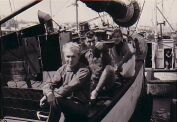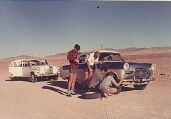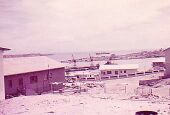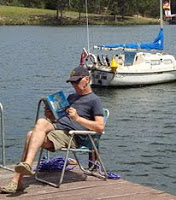The harbour of Lüderitz
The building with the blueish roof at the bottom of the photograph was my office
South West Africa, or Namibia as it is called now, stretches north from South Africa's Orange River along 1280 kilometres of the loneliest, yet in parts most hauntingly beautiful coastlines touched by the Atlantic Ocean.
 The Namib desert, whose desolate sands have trapped and killed thousands of men and women of every race as they sought to unlock its secrets or merely to survive, runs right to the sea. The local Ovambo people call Namibia "the land God made in anger" and as the sun mercilessly bakes deserts, plains and mountains alike, it is a close cousin to hell.
The Namib desert, whose desolate sands have trapped and killed thousands of men and women of every race as they sought to unlock its secrets or merely to survive, runs right to the sea. The local Ovambo people call Namibia "the land God made in anger" and as the sun mercilessly bakes deserts, plains and mountains alike, it is a close cousin to hell.
In late 1968 I flew into Windhoek and spent a few days at the "Head Office" of Metje & Ziegler before boarding the overnight train for the 11-hour trip to Lüderitz. The landscape was desolate! Occasionally, throughout the night the train would stop and natives would climb down from the locomotive with brooms and shovels to clear wandering sand dunes from the track.
I spent six months in Lüderitz, which has a very interesting history, where I worked as a book-keeper for Metje & Ziegler Ltd. to earn the necessary money for a passage from Cape Town back to Australia.
 Karl-Heinz Herzberg, myself and a friend aboard a trawler in Lüderitz Harbour
Karl-Heinz Herzberg, myself and a friend aboard a trawler in Lüderitz Harbour
Lüderitz was a very German town and German was spoken as much as Afrikaans (with a bit of English by those who were neither Germans nor Afrikaners). I bought myself an "Afrikaans-Duitse en Duits-Afrikaanse Woordeboek" at the Callesen bookshop in Windhoek for Rand 1.75, but never had to use it much as everyone understood, if not spoke, German.
More than fifty years later, the dictionary is still in my library, in almost mint condition, together with dictionaries of Arabic, Burmese, Farsi, French, Greek, Indonesian, Malay, Samoan, and Pidgin.
 Helping with a flat tyre
Helping with a flat tyre
I shared a flat in a company-house with Karl-Heinz Herzberg, another young German who had emigrated to South Africa some years before and, after a time in Johannesburg where he worked underground in a goldmine, had come to South West Africa. He was a kind and generous friend whom I remember with great fondness and with whom I have maintained a contact to this day. (As it turned out, Karl-Heinz would never leave South West Africa: he married in 1972 and ever since has been running a farm near Helmeringhausen in the interior of the country.
Check it on GOOGLE Map
The "kantoor" in which I had to spend my entire day was straight out of Dickens: dusty, old-fashioned, and run by an Afrikaner woman by the name of "Mevrou Russo" who "commandeered" two other Afrikaner women who treated the blacks, referred to as "die goed" [these things], abominably. They must have been lying awake at night worrying about the "swart gevaar" [the black danger]. What their jobs were never became clear to me. Then there were three German men who had something to do with the fuel storage down by the harbour and the hardware store behind the office. The whole lot was presided over by a thin and ageing man not very flatteringly referred to as "Lügen-Müller". My own work was simple and undemanding: keeping a mechanised debtors ledger (on a ledger-machine straight out of the Ark), reconciling several bank accounts, and other bits and pieces around the office. It was a completely dead-end job!
There wasn't much to do outside working hours either: the occasional "braaisvleis" (barbecue), "kegelspeel" (more beer than skittles) at Kapps Hotel on a Friday night, and a weekly visit to the local "bioskoop" (picture theatre). It was at the "bioskoop" that I watched in full colour the world's first heart transplant performed by a Dr. Christiaan Bernard at the Groote Shuur Hospital in Cape Town on 3 December 1967. Not that I remember much about it as I promptly fainted!
 View from my window
View from my window
However, my memories of South West Africa and Lüderitz are forever linked with the music of Miriam Makeba ("The Click Song - Qongqothwane") and Marianne Faithful ("This is the evening of the day, I sit and watch the children play, smiling faces I can see ..") which my flat-mate Karl-Heinz played again and again on his record-player. Even though located on the Atlantic coast in Southern Africa, the cold Benguela Current turned swimming at Lüderitz into a rather masochistic activity as the ocean temperature rarely rises above 12 degrees Centigrade.
Lüderitz is surrounded by the vast "Sperrgebiet" a 'no-go' diamond-mining area controlled by Consolidated Diamond Mines, or CDM as it was generally known, who created their own town Oranjemund at the mouth of the Orange River for the ten thousand or so Ovambos (the black people of the area) and thousand whites employed there. There was a time when diamonds were found simply lying on the beach and an anthropologist, Dr M.W.D.Jeffreys, believed this to have been the coast referred to in the tale in A Thousand and One Nights which tells of a beach strewn with jewels.

Six months in Lüderitz seemed a long enough servitude but the company didn't quite see it the same way as they insisted that I repay them the inward airfares before they allowed me to leave. I squared my account with them which left me with just enough money for the flight down to Cape Town and my sea passage back to Australia.
I liked Cape Town. South Africa's Mother City was seductive: although a big town (at last count 2.86 million in the metropolitan area alone), local people seemed not only to be on permanent vacation, but also proud of it ("You know why they call it the Mother City?" goes the wisecrack. "Because everything takes nine months to get done."). Then there is the dramatic backdrop of Table Mountain (named by Jan van Riebeeck on 6 April 1652) which is the very reason for Cape Town's existence as European explorers stopped and rested here in the early 1500s to restock their water supplies from a freshwater stream spawned near the top of the mountain. Early Dutch sailors were so delighted to drop anchor there that they rewarded the first seaman to sight the mountain with 10 guilders and a jug of wine.
I sampled the delights of Cape Town for a couple of weeks, hitched a vertiginous ride on the barrel-shaped cable car to Table Mountain's peak, and watched the ships come and go in Table Bay but although I was given the chance to join the local VOLKSKAS Bank, my mind was made up to return to Australia and from there to try and get to New Guinea. So, eventually, I boarded CHANDRIS LINE's "Ellinis", destination Sydney/Australia.
I discovered a book in a second-hand bookshop, The Sheltering Desert (German title: "Wenn es Krieg gibt, geh'n wir in die Wüste"), which is set in the Namib Desert in the area around Naukluft. It was also made into a movie - click here.
Recently, I also bought the DVDs "The Gods Must Be Crazy" and "The Gods Must Be Crazy II" (German title: "Die Götter müssen verrückt sein"). My travelling days are long over and I now live quietly at "Riverbend" on the South Coast of New South Wales in Australia but whenever I want to relive some of my memories of South West Africa, I watch one of these movies. Even though shot in neighbouring Botswana, the scenery in these films is very reminiscent of South West Africa.










